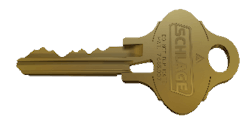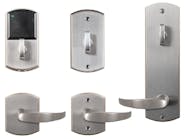On July 11, 2012, Ingersoll Rand Security Technologies announced the Everest 29 patent protected key system. Everest 29 cylinders and keys incorporate all new keyways with the patented undercut groove on the right side of the key section. The patent prevents unauthorized key duplication. This key system is available in full size and Small Format Interchangeable Core cylinder formats. The Everest lock cylinder plugs have the Everest logo stamped into the face. The 29 indicates the United States patent 7,665,337, 17-year protection culminating in 2029.
A new undercut design utilizes a unique key machining process, which includes cutting a hole in the bow in order to create the lip as the undercut groove is cut into the Everest 29 key blade. The keyway of the Everest 29 lock cylinder plug has a corresponding profile tongue with a downward projecting end. As the key is inserted, this undercut groove fills the undercut portion of the key profile groove. The lip along the edge of the blade raises the spring-loaded check pin out of the cylinder shell into the body of the plug.
Like the Everest, the Everest 29 has two lock mechanisms to resist manipulation and tampering. The pin tumbler lock mechanism is operated by a bitting sequence cut into the blade that corresponds to the operating pin lengths. The second lock mechanism is the check pin. The key must move both the pin tumblers and check pins to the shearline in order to operate the lock cylinder.
Important: Everest key blanks have a portion of the undercut lip removed to prevent the keys from being used for Primus locks.
Everest Compatibility
The new undercut groove on the right side of the Everest 29 key blade is backwards compatible with existing Everest B, C and D keyway lock cylinders. The Everest 29 "R" interchangeable core (SFIC) restricted keyway cores and key blanks are backwards compatible with the Everest "B" cores. Everest 29 "S" full-sized open keyway lock cylinders and key blanks are backwards compatible with the Everest "C" lock cylinders. The "S" keyway lock cylinders and keys can be stocked and sold by all locksmiths. There are ten keyways including the S123 and S145. Everest 29 "T" full size restricted keyway lock cylinders and key blanks are backwards compatible with the Everest "D" lock cylinders. Everest keys will not enter Everest 29 lock cylinders.
Note: The Everest 29 S123 will become the default keyway for non-master keyed Schlage locks and the S145 will be the default keyway for new factory masterkey systems.
Everest 29 is available in different levels of key control. The essential difference is Everest 29 is available to the locksmith or the end user. End-user exclusive systems would include large hospitals, universities and facilities that have their own locksmith. End-user exclusive systems have the side bit milling assigned to and owned by end user. End-user exclusivity ranges from a randomly based national pool of available combinations to national exclusivity.
Dealer controlled systems are available for locksmiths who own and stock Everest 29 locks and keys, and those who obtain their locks and keys through distribution. The stocking locksmith Everest 29 keys are stamped with the dealers' ID based on first three digits of zip code. The dealers’ exclusivity of side bit milling is also based on zip code. The stocking locksmith has a sole source relationship with the end-user.
Locksmiths selling directly to end-users are also eligible for side bit milling exclusivity. The exclusivity is for the dealer’s physical location time zone. Locksmiths with this exclusivity have a sole-source relationship with their end-users.
The original Schlage Everest key system patent date was Feb. 10, 1998. The original Everest key bow is larger than the previous (Classic) Schlage key bows, having the Schlage name in a larger font. The Everest 29 key bow has a more oval bow shape. Coined Everest and Everest 29 key blanks have the Everest logo in the bow. Schlage Everest and Everest 29 lock cylinders have the Everest logo stamped into the face of the plug.
Servicing Everest 29 Cylinders
Servicing the Everest 29 lock cylinder is similar to the conventional Schlage lock cylinders. If the lock cylinder is a key-in-lever or modular rim cylinder, remove the cap, tailpiece, driver and spring. If the Everest lock cylinder is mortise cylinder, remove the cam.
Insert an operating key and rotate the plug approximately 90 degrees. Push the plug out of the shell using a plug follower.
Important: The key keeps the check pin in place when the plug is removed from the housing. If the key is removed, be careful not to lose the check pin and spring.
Carefully remove the top pins and springs from the shell, and then remove the bottom pins from the plug.
Schlage full sized lock cylinders are designed to use a balanced pin stack. If the total length of the bottom pin and master pin (if used) is 0 to 3, a number #1 top pin (.235") is installed. If the total length of the bottom pin and master pin is 4 to 6, a number #2 top pin (.200") is installed. If the total length of the bottom pin and master pin is 7 to 9, a number #3 top pin (.165") is installed.
Combinate the lock cylinder using new top pins, master pins and bottom pins, and springs.
If no operating key is available, disassembling the lock cylinder is a two-step procedure, as the check pin must be raised in order for the plug to be removed. A special removal key is required to raise the check pin to the shearline if no operating key is available.
To create a removal key, cut an Everest 29 key blank blade to a number nine depth. Make sure the cut portion of the blade is flat, so it can be slid into the keyway once the lock cylinder has been shimmed.
Shim the pin tumblers to clear the shearline. Leave the shim in place and remove the key blank. Insert the removal key. Once the check pin has been raised, rotate the plug 90 degrees and remove using a plug follower.
The Schlage Everest 29 patent protected key system provides key control, limiting the possibility of unauthorized access. Selling Everest 29 locks and keys provides your customers with patent protection. In addition, Everest 29 key system users can also incorporate Primus XP lock cylinders for exterior and other applications where high security lock cylinders are essential.
Ingersoll Rand will continue to support the Everest product.
For more information, contact your local locksmith distributor or Schlage, Web Site: www.schlage.com.
To read additional Locksmith Ledger articles about Schlage Everest patented keys, visit http://tinyurl.com/everest1-13.





